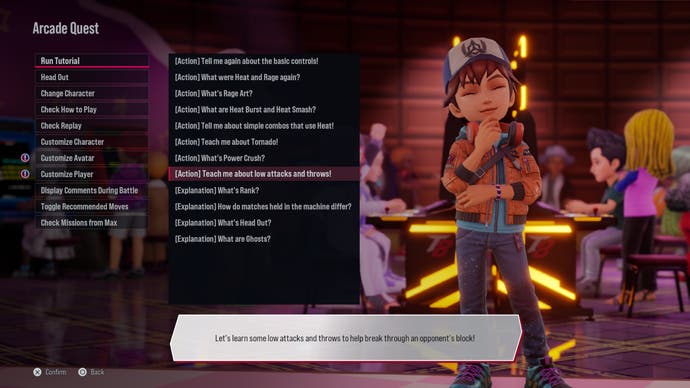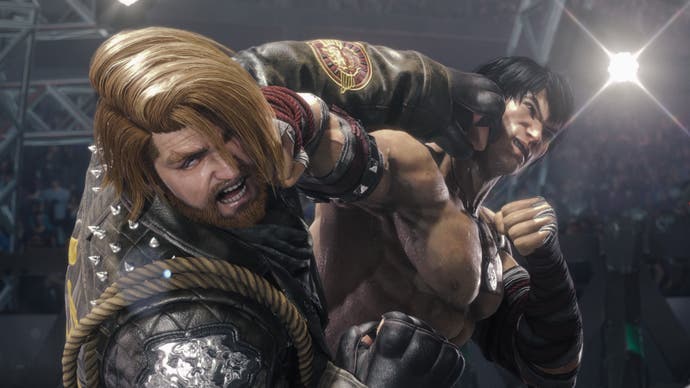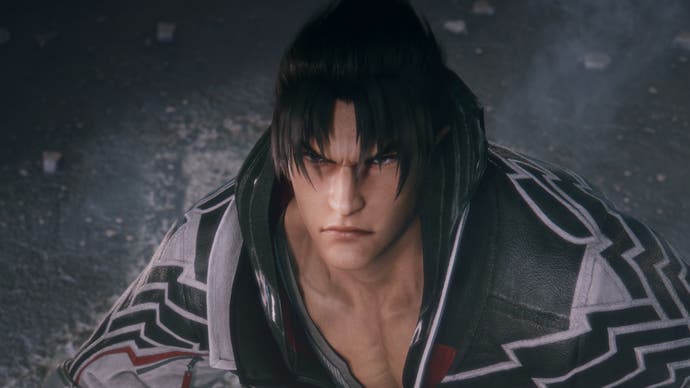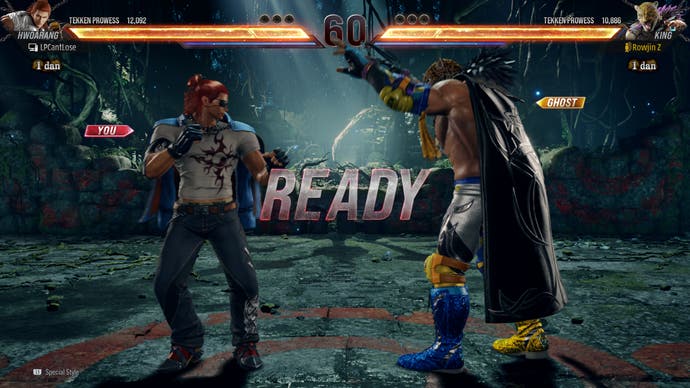I suck at Tekken. Even as someone who considers themselves to be well versed in the fighting game community's language and terminology, I've always found Tekken to be uniquely impenetrable when compared to its contemporaries.
it was due to the wealth of poorly explained legacy mechanics whether brought over from previous entries, the unnecessarily abstruse instructions in a character's already dauntingly large movelists, or the franchise's weird disdain for tutorials in general, improving in each new Tekken title has felt like an insurmountable task. I have reached a point in every new iteration where I had to turn to YouTube guides – more often than not recorded by some poor nervous guy heavily breathing into his microphone as he umm'd and ahh'd his way through explaining what a just frame move is – because the knowledge required to actually play the game wasn't readily available within the game itself.
Tekken 7 was the epitome of these frustrations for me, a game that only taught you a sliver of what you could actually do during the main story mode, didn't feature a tutorial outside of this, and then had the gall to try to sell players frame data for its practical mode as DLC after the fact. When compared to Tekken 8, the two games couldn't feel more distinct, and it's all the better for it. For the first time in the series history, I can confidently say that I finally feel like I know what I'm doing.
Manage cookie settings
In stark contrast to previous Tekken entries that omitted a tutorial completely, Tekken 8 has instead dedicated an entire mode solely to learning its core moves. Arcade Quest will undoubtedly draw comparisons between it and Street Fighter 6's World Tour mode, but while both share the same intention – of elevating what would otherwise be a boring tutorial by transforming it into a narrative that players can follow while they learn – Tekken 8's take on the idea is a lot more simple, and does an incredible job of highlighting the litany of mechanics that separate Tekken from other fighting games.
Your teacher, Max, will routinely force you to complete training exercises in-between fights at the arcades – exercises that are specific to the character you are currently using. Each new mechanic you are taught is tailored towards the opponents you'll be facing next, and they're always immediately necessary to progress. For instance, the opponents in one of the final arcades you visit are extremely aggressive but also have tight defenses, forcing you to put Max's training into practice by using the reversals he just taught you to counter them.


That isn't to say that Arcade Quest is exhaustive however, as I did find that a few specific things weren't touched upon during Max's lessons, such as wall jumps and the universal low parry, but rather that it does an admirable job of condensing what it does cover into easily digestible chunks. Keeping Arcade Quest and story mode separate from one another also comes with the added benefit of allowing seasoned Tekken players to ignore the mode entirely, as practice mode will offer them everything they need to get up to speed with the newer systems introduced in Tekken 8, while simultaneously avoiding the need to shoehorn a tutorial into the storyline that would otherwise detract from the wonderfully absurd plot of Tekken.
If Tekken 8's story were a hot sauce, it would be Da Bomb Beyond Insanity. The story recaps you can see before you start do their best to get you up to speed on the lore, but there's only so much they can do to prepare the uninitiated for what will follow. The narrative whiplash that occurs when shifting from watching Jin desperately try and fail to defeat his father in a bid to atone for his past sins, to a cutscene where an Italian exorcist (voiced by Ezio Auditore's voice actor Diego Baldoin) debates the finer intricacies of Morality with a panda (named Panda) can not be overstated – but it's a ridiculously enjoyable ride in spite of it. Or possibly because of it. And considering the actual content of the story, the voice acting really is perplexingly good. The conviction that the dialogue is delivered with only proves to enhance the silliness, especially whenever I reminded myself that Victor is voiced by César Award winning actor Vincent Cassel.
One thing Tekken 8 doesn't nail quite as well as Street Fighter 6 is the implementation of its “Special Style” control scheme, an option players can turn on with one simple button press during the match. Much like Street Fighter 6's Modern control scheme, Special Style transforms single button presses into special moves that would usually require specific inputs, allowing you to pull off complex combos by simply hammering away at one button repeatedly.


Unfortunately in Tekken 8's case, the characters have access to such a large repertoire of moves as standard that using Special Style feels limiting, in a way that it never did in Street Fighter 6. So many ways to approach your opponent, or end a combo safely, simply no longer exists when Special Style is activated, essentially trading easier combos for a reduced chance at landing any combos in the first place. It is still a nice option for story mode, when you're forced to use a character you're unfamiliar with – or for your friend to use when they try the game for the first time – but outside of this it is far too much of a hindrance and will actively stunt the growth of players who genuinely wish to improve. That being said, the inclusion of an easier control scheme is something to be lauded regardless, given that any attempt to improve a game's accessibility and approachability is something to be celebrated. At the very least, it shows that their heart is in the right place.
Considering how spectacular the game looks on PC, the performance was borderline faultless. I didn't experience any bugs or mishaps of any technical variety throughout the entirety of my sixty hours spent playing Tekken 8 – except for some brief frame drops during the shift from gameplay to cutscene during the final act of the story. I should state however that it only took me roughly six hours to complete everything both the story mode and Arcade Quest had to offer, so those looking to play Tekken purely for its single player experience may come away disappointed. There are 32 Character Episodes to complete for every character too, each with their own unique story and cutscene to unlock, but each of these will likely only take you five to ten minutes to complete.


Instead, you'll most likely find yourself spending most of your time in both practice mode and in the online lobbies. Practice mode already felt robust in Tekken 7, but a few usability improvements, such as the ability to cycle through your movelist without even needing to open the menu, have streamlined the process of labbing to such a degree that it actually resulted in me spending less time in practice mode and more time playing online. And as for that online experience, in the two days I was able to test it with active servers, matchmaking felt silky smooth regardless of how far away my competitors were. Matches from here in the UK with players from both America and Asia never resulted in anything beyond two frames of rollback, even when my opponents didn't have perfect connections.
Options for interacting with other players in lobbies, meanwhile, were surprisingly deep – even if the Xbox Live Arcade-esque characters everyone had created did ultimately end up looking pretty similar, thanks to some limited customization options. In one particular instance, I noticed two players fighting against each other at one of the arcades, so rather than waiting aimlessly for them to finish I instead opted to challenge both of their ghosts.
You can download or immediately fight the ghost of any player you encounter in a lobby, creating an AI trained recreation of how they play their character of choice, that updates every day said character is used online. If you so choose, you can even challenge your own – a humbling experience when I noticed that my own Hwoarang's ghost repeating the one combo I'd learned ad nauseam. Challenging the aforementioned ghost of my opponent, however, was actually surprisingly insightful, considering how closely it matched their current playstyle when I finally had the chance to fight them after their previous bout had finished.
With 32 characters available in the base roster, the largest amount available in any big-budget fighting game at launch in recent memory, I didn't get the chance to extensively test every fighter – but the ones I spent the most time with were newcomers Victor, my old main Hwoarang, and, to my own surprise, my new main Jun. Every character feels so different, and their playstyles are so varied, that it did feel overwhelming trying to decide who to play or who felt the strongest at a glance, but the most important thing is that each and every one of them felt fun to play. The new Heat mechanic did seem to favor some characters more than others however, as characters like Victor only seemed to get increased damage while in Heat, while others unlock new moves or, in Alisa's case, make them capable of dealing a frankly offensive amount of chip damage to your opponents when certain special moves were blocked.


In the past, I've attempted to properly learn three different Tekken games, Tekken 5, 6 and 7, but I always gave up after investing dozens of hours into each of them. These are legacy games at heart, the fighting game equivalent of a perpetual stew. Those massive movelists each returning character have are a result of literal decades worth of refinement, characters that have been tweaked and edited from one game to the next. That impenetrable quality I referred to before didn't just come from a lack of instruction, it came from a sense of starting each game on the back foot.
A lifelong fan of any fighting game series will naturally come into its next iteration with a massive advantage over a newbie, regardless of what changes have been made, but Tekken has been the only fighting game series that made me think that attempting to catch up was an impossible task.
A copy of Tekken 8 was provided for review by Bandai Namco.
#Tekken #review #complex #series #transformed #welcoming